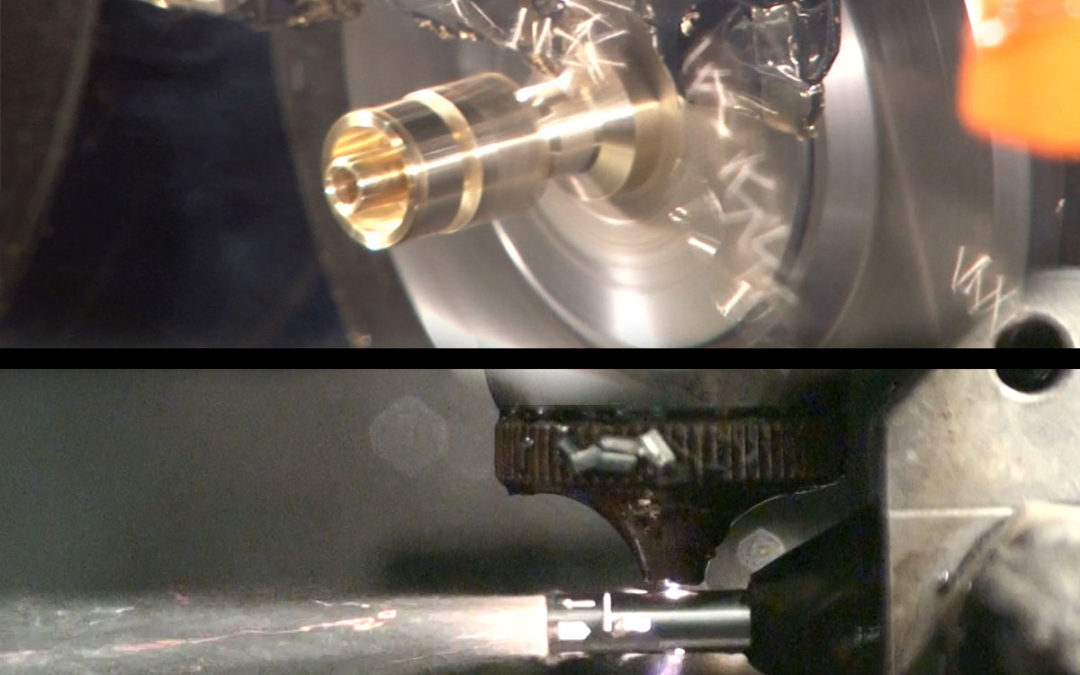Laser tube cutting is a process in which a laser beam is focused on the outside surface of a metal tube to perform a cutting operation. The tube is fed in various patterns beneath the focused laser beam, where the tube wall is melted through. In medical applications with smaller tube diameters, the laser’s beam width is approximately .10 mm (.004”). Our machines are equipped with fiber lasers.
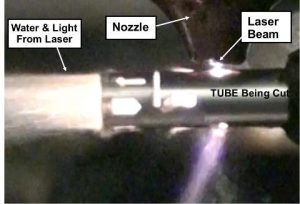
Close-up of Laser Tube Cutting Process
In the case of most laser machines, the laser is stationary and aimed directly toward the center of the tube. The tube that is being cut is fed through a stationary guide bushing—a “slip-fit” mechanism which stabilizes the tube while keeping it aligned and at a proper distance under the focused laser beam. Behind the guide bushing, the tube is held firmly by a programmable 360-degree indexing collet. This device can rotate the tube and has the ability to simultaneously push and pull the tube axially through the guide bushing. The CNC controller delivers the programmed instructions to these mechanisms, which cuts out the desired shapes and configurations from the tube.
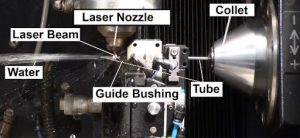
Additional Details of Laser Tube Cutting Process
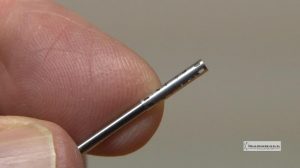
Photo of finished “laser cut” part from above examples
2 + 2 Axis Laser Cutting
Marshall’s laser tube cutting machines offer 2 + 2 axis. Two axis rotate the tube and axially move the tube. The additional two axis can be programmed to move side to side, and up and down.
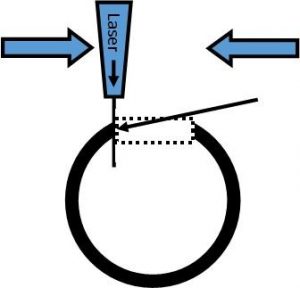
2+2 Axis Diagram: When Y-Axis is utilized and the tube is not rotated, the laser beam cuts an off-center rectangle through the wall of a tube—and a vertical cut is produced on the longitudinal edge of the cut.
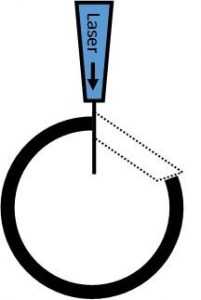
3 Axis Diagram: When there isn’t an active Y-Axis and the tube is rotated—and the laser beam is directed towards the center of the part when cutting a rectangle through the wall of a tube—a bevel (trapezoid) is produced on the longitudinal edge of the cut.
This video link (starting at 0:34 seconds to 00:52 seconds) demonstrates the laser tube cutting operation using only three of the four axis available. The laser remains stationary in the video, continually focused at the center of the part. The raw tube length is 3,660 mm (10 feet), and after the cutting process is completed, the finished part is severed from the initial tube. As each part is manufactured, the raw tube becomes shorter, until a new tube is loaded into the machine. The guide bushing is pictured immediately to the right of the laser beam, and the indexing collet system is on the far right of the picture.
In this example, the material diameter is 2 mm in diameter (.78”), and the finished part is approximately 11mm (.433”) in length. The wall thickness of the part is .10 mm (.004”). As you can see from the video, the tube has a multitude of cut features. Lasers can run wet or dry, and in the accompanying video, water is forced through the end of the tube. This prevents slag from building up on the through-cut-edges of the part—as well as eliminating slag on the wall opposite of the cut.
Minimal “Heat Affected Zone” (HAZ)
The heat affected zone is the area of the tube which doesn’t melt, but is affected by the heat of the laser, which alters the microstructure and mechanical properties of the tube. The heat affected zone is minimal when considering the following:
- The very small laser beam-width of .10 mm (.004”)
- The thin wall of the medical hypo tube
- The feed rate of the material
- The forcing of water through the tube.
Marshall can accommodate tube diameters ranging from .5 mm to 8 mm (.020” to .315”). Maximum wall thickness is approximately .5 mm (.020”) with most materials.
Advantages of Laser Tube Cutting
Laser tube cutting offers a range of unique advantages compared to other manufacturing processes. For example, laser tube cutting tools do not apply mechanical force to the cut, unlike CNC punch or cutting machines. This unique feature helps ensure that minimal stress is applied to surrounding material, which protects and keeps the tube strong at the point of the cut.
Another reason to choose a laser tube cutting machine over conventional cutting tools is efficiency. When tubes are cut by traditional physical tools, they often leave small imperfections that must be smoothed out later. Most tube cutting solutions also require secondary action to produce more complex features in the piece (such as cutout designs). Laser tube cutting machines reduce these inefficiencies by cutting the piece to length and adding holes or other required features in a single step, driving more productive and cost-effective operations.
Along with eliminating manual and secondary processes, laser cutting tools can reduce maintenance steps and costs to enhance productivity. Fiber laser machines require minimal cleanings and checks, and beyond the need for routine air filter replacements, these solutions require very little preventative maintenance. The modules of fiber lasers also allow for redundancy, meaning that the resonator can remain functional until the down module is identified and repaired.
Laser cutting machines are even more efficient when compared to physical cutting tools. Because their tooling runs out relatively quickly, physical cutting machines require constant service and repair—which directly stunts productivity and throughput. Compare that to laser cutting tools, which can operate with little maintenance for many hours, and it’s clear why many companies are leveraging this exciting technology today.
Disadvantages of Laser Tube Cutting
Despite their strengths, laser tube cutting machines are not ideal for every type of project and manufacturer. This is especially true for solutions with a traditional CO2 resonator. Creating a CO2 laser requires significant amounts of power compared to a fiber laser, resulting in lower power efficiency. CO2 laser machines also feature poor wall plug efficiency compared to fiber lasers, which means they require additional (and highly valuable) floor space.
There are also limitations in regards to laser tube cutting materials. Laser cutting is not suitable for every type of material—and can even damage the machine’s cutting lens when used with incompatible metals. This risk can be offset by researching and confirming compatibility to ensure you choose the proper machine for all cutting operations.
Laser tube cutting is a complex technology by nature, particularly when compared to conventional CNC tools. As a result, deploying this solution for your project requires careful consideration and planning. Be sure to contact Marshall if you have questions or concerns about whether laser tube cutting is the right choice for your upcoming project. Our experts can walk you through our unique approach—and the value we can provide as your manufacturing partner.
Core Applications for Laser Tube Cutting
Because tubes are used across a wide variety of products and applications, laser tube cutting is in high demand for many industries. It’s also important to note that these systems can be used to cut more than just tubing, including pipe, flat stock and extrusions. Some of the most popular markets for this technology include:
- Healthcare/Medical Device Manufacturing
- Architecture/Design
- Automotive/Vehicle Construction
- Chemical/Petrochemical Tubing
Unlike traditional laser cutters, laser tube cutting machines are optimized for processing cylindrical pieces and objects. Beyond basic vertical cuts, these tools can be used to produce slots, etchings, bevel cuts, angle cuts and more with excellent consistency and repeatability.
Laser tube cutting machines are flexible enough to produce almost any cutout shape in a piece, giving manufacturers more design freedom than ever before. They can be used to cut round, oval, and even square tubing with remarkable accuracy. Thanks to its precision and efficiency, laser tube cutting is ideal for producing custom-shaped tubes for a host of applications.
Laser Tube Cutting Materials
Fiber laser tube cutting machines are compatible with a wide variety of materials, including copper and brass. The small wavelength of fiber lasers allows these solutions to create a beam that can easily be absorbed by these reflective materials. Some laser tube cutting tools can even alter their beam’s width to process thinner vs. thicker materials, allowing different-sized materials to be processed on a single machine.
Laser Tube Cutting Services: Providing Repeatability & Accuracy
At Marshall, our laser tube cutting machines can generally hold tolerances of +/- .013 mm (.0005”), at very high repeatability levels. These machines are set up at Marshall to manufacture medium to high volumes with faster cycle times—and lower to medium volumes with slower cycle times. Be sure to connect with us for more insight into our full capabilities for laser tube cutting.

